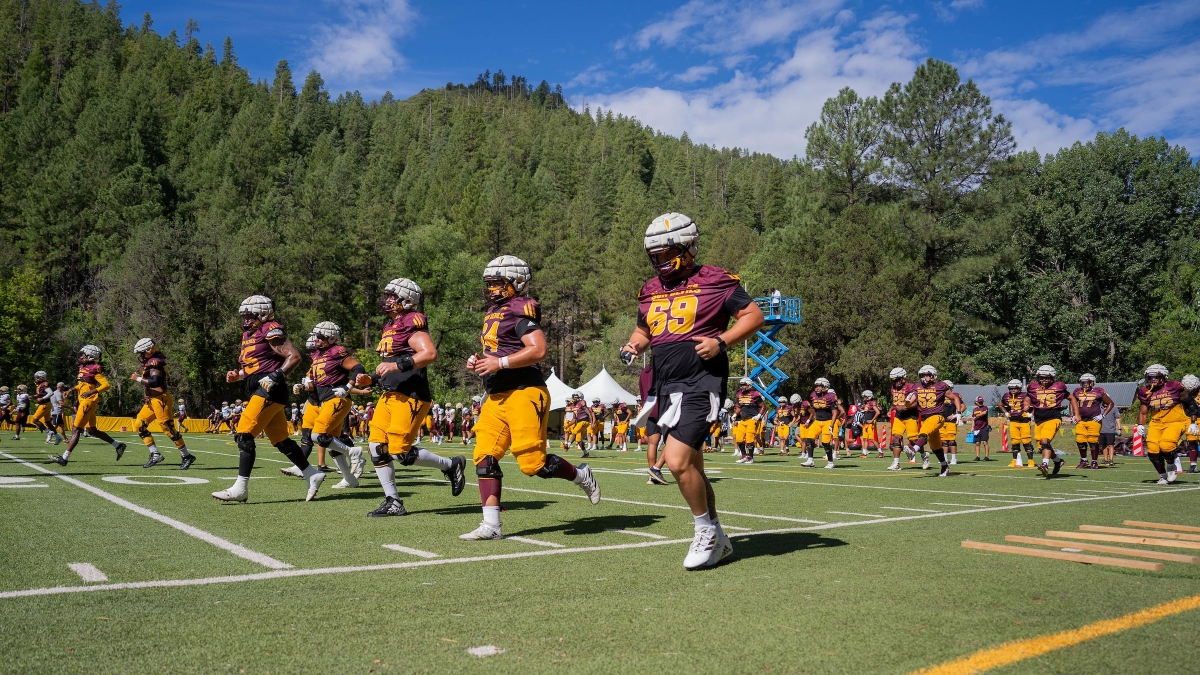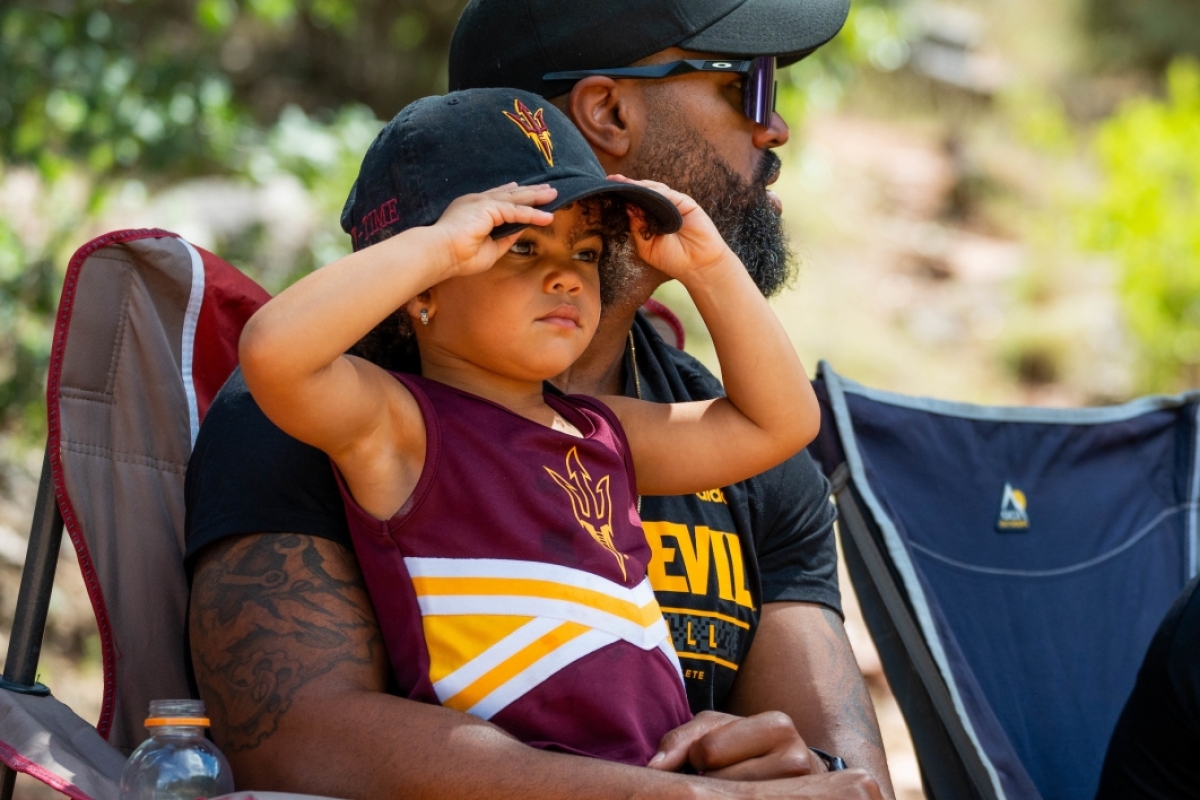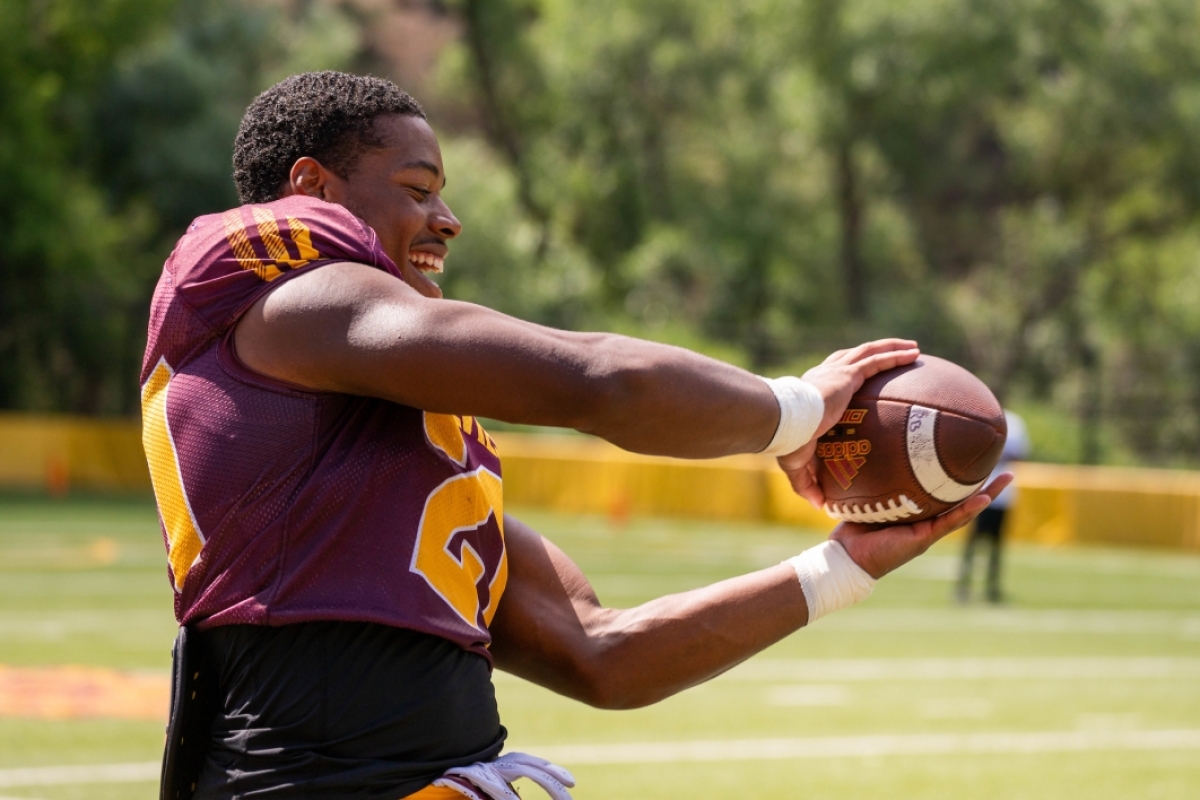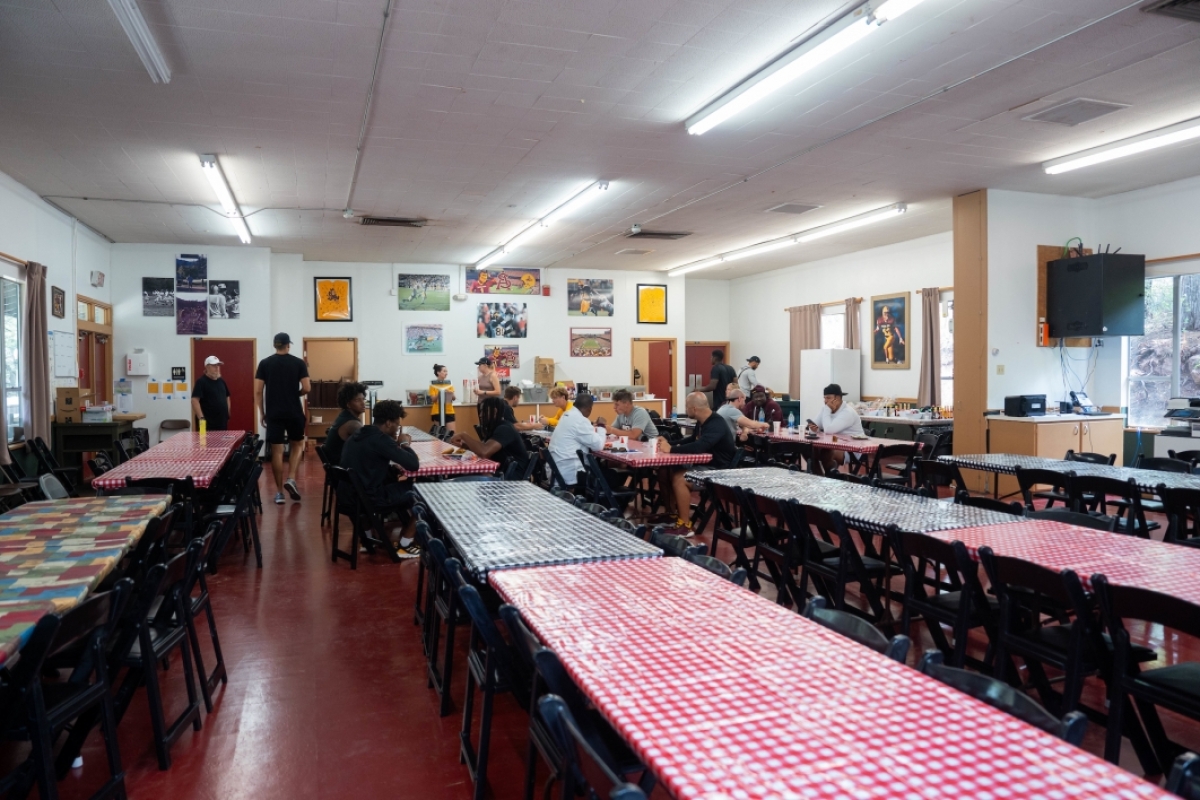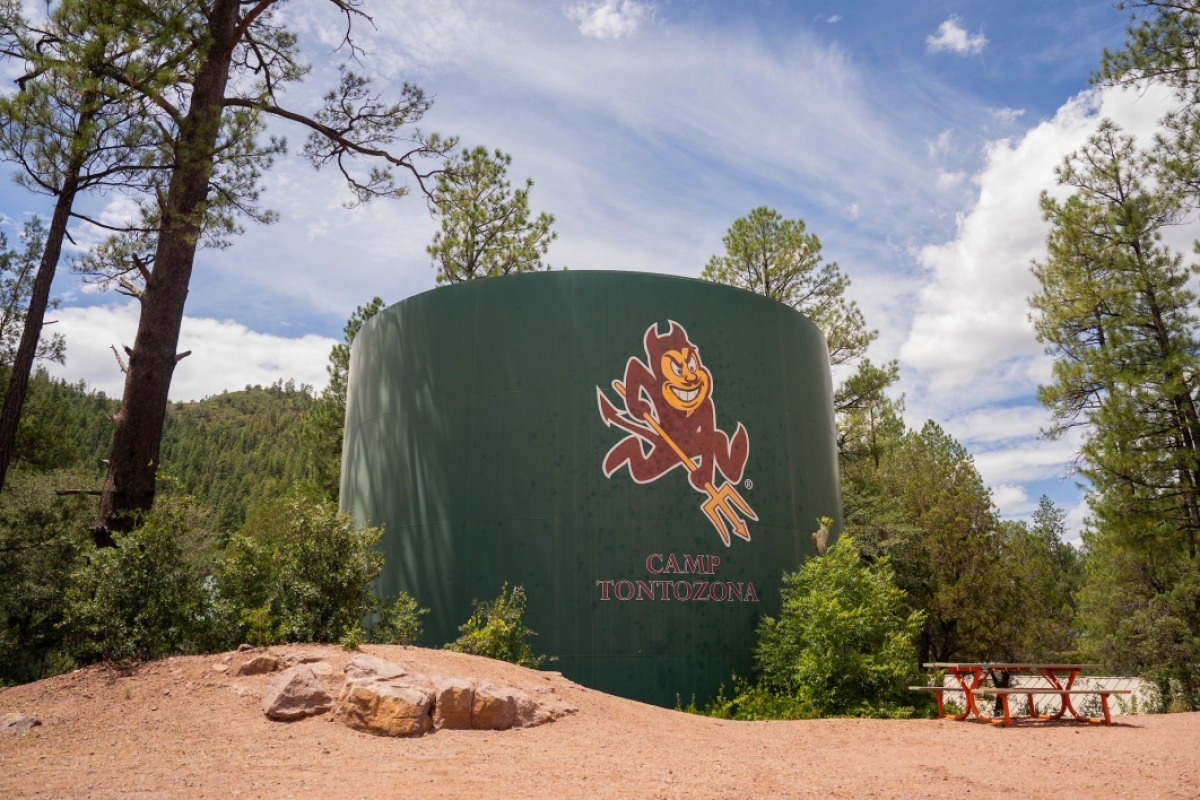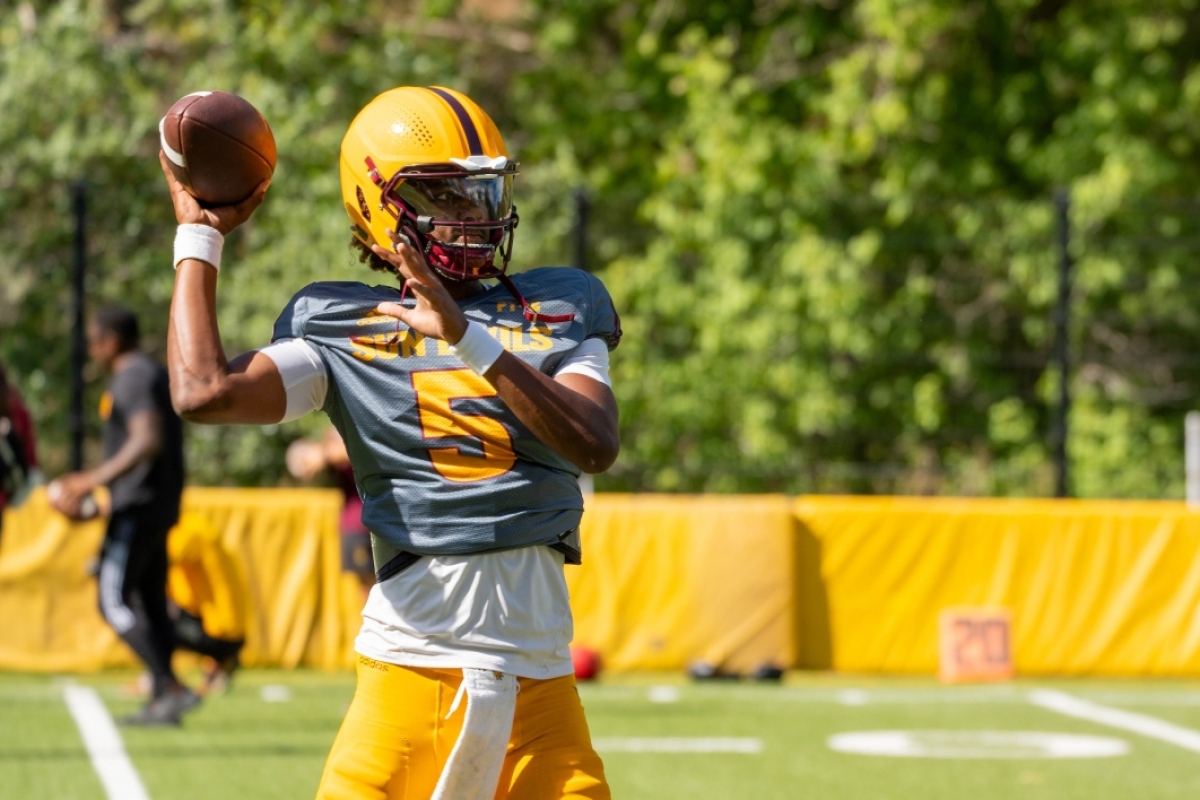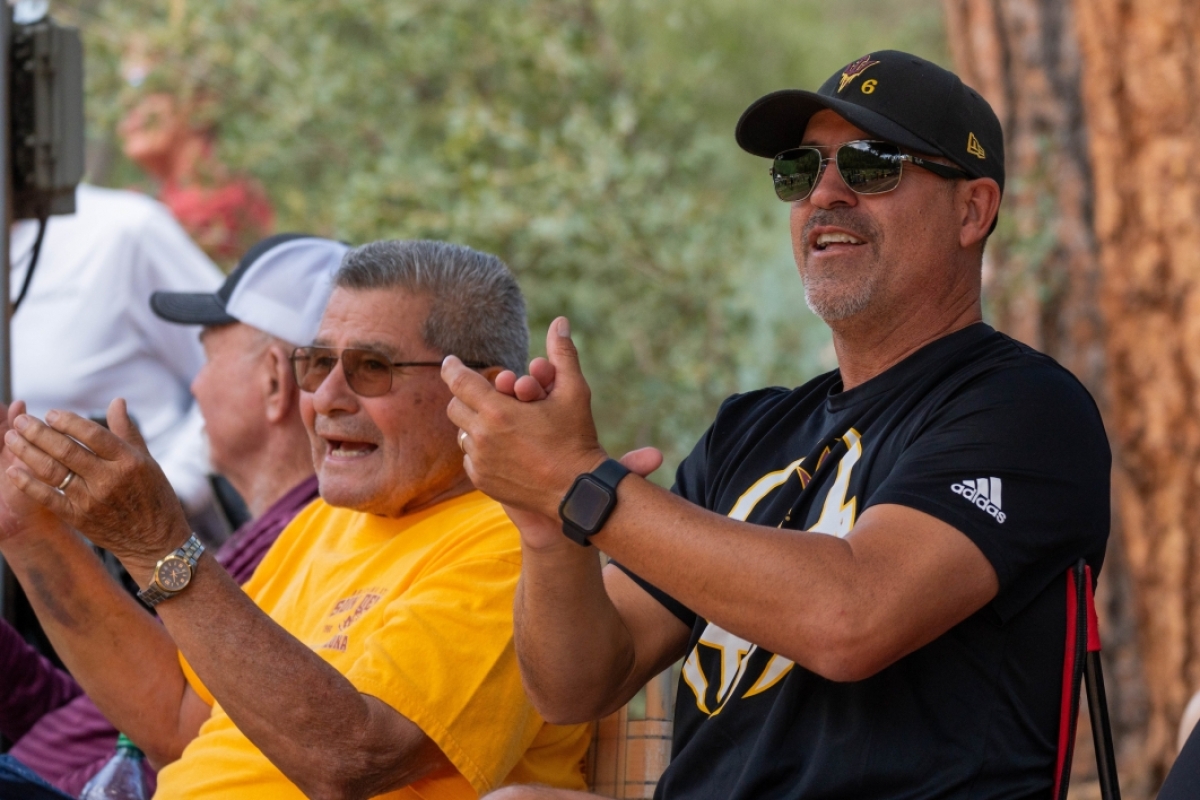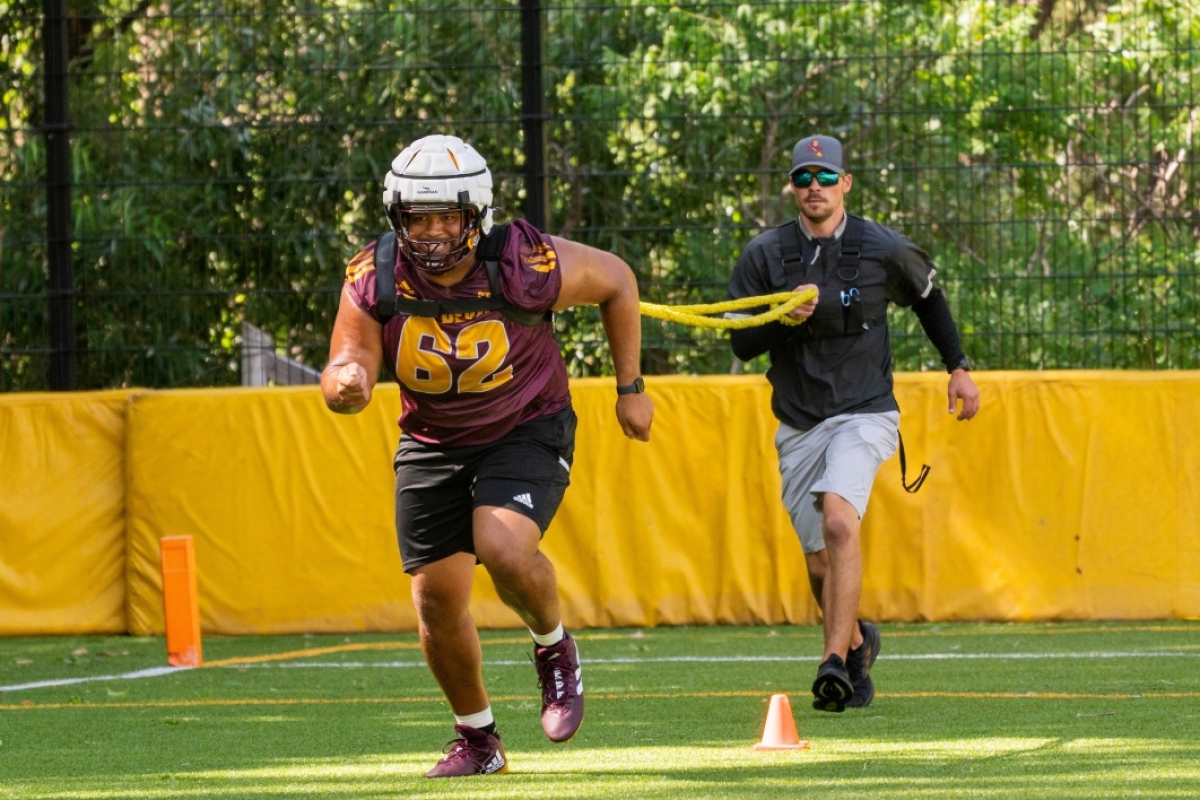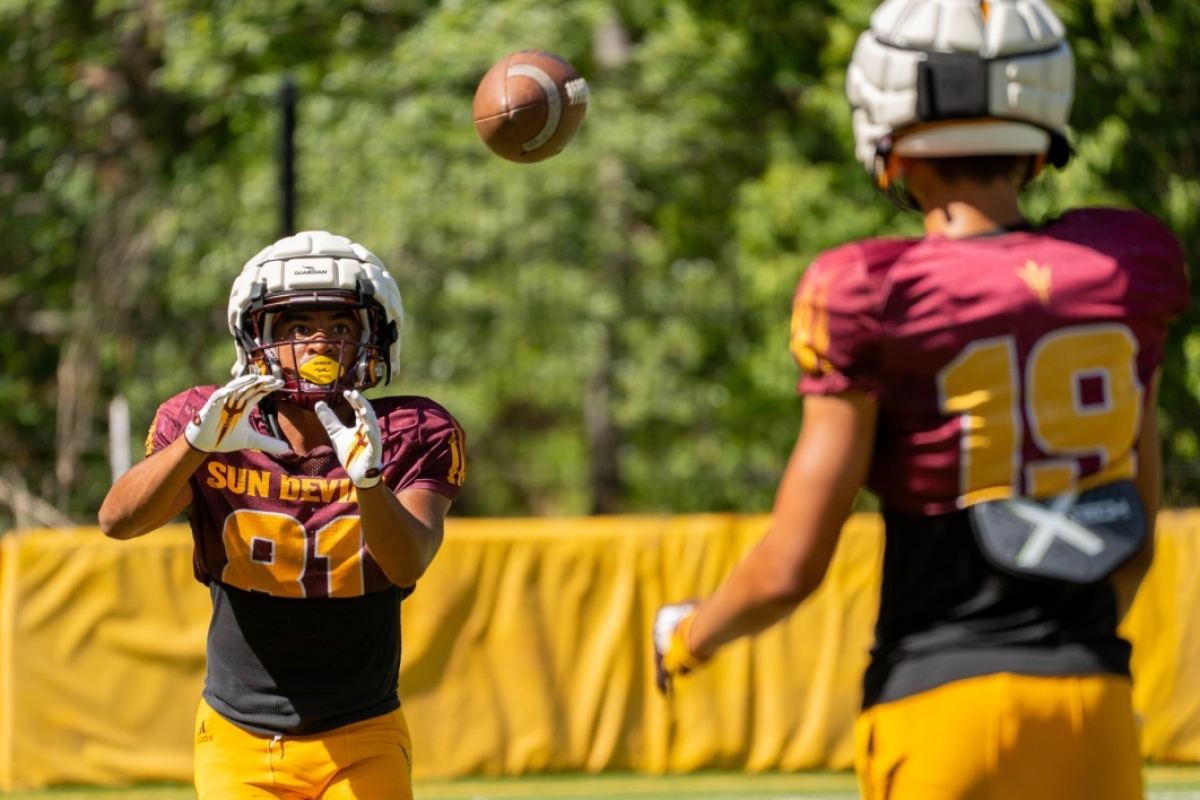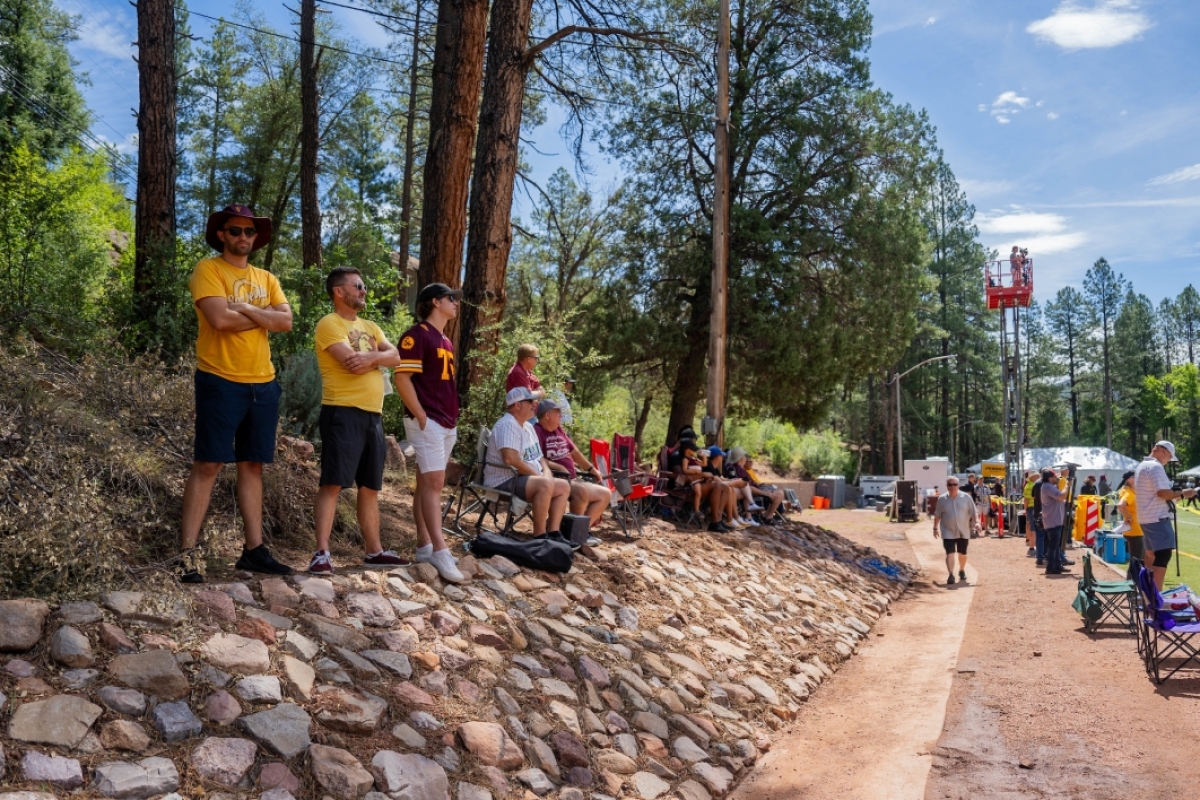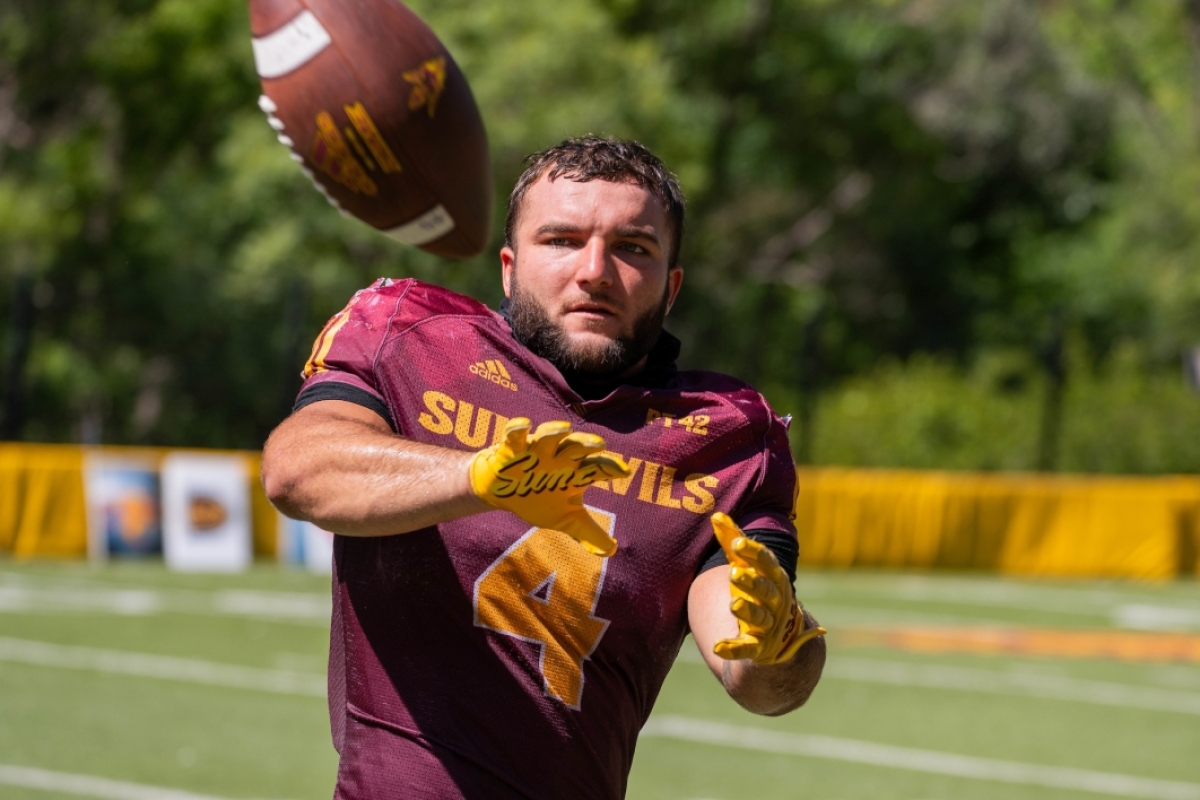CAMP TONTOZONA — Rudy Burgoz slightly grips the arms of his lawn chair as he looks down on the scene below.
He’s sitting in the shade Thursday, a few feet away from Arizona State University’s practice field at Camp Tontozona, just outside Payson, Arizona.
Burgoz, a longtime Sun Devil football fan, has been coming to this bucolic setting since 1961, just one year after Coach Frank Kush brought the Sun Devils up north for the first time.
He remembers surreptitiously bringing beer to the players back then and when an assistant coach found out what was going on told Burgoz, “Get the hell out of here.”
But Burgoz would be back. In fact, years later he bought a cabin 42 miles away so it would be more convenient for him to come to practice.
“Since 1996, I’ve been here just about every day,” he says.
As Burgoz is talking, first-year Coach Kenny Dillingham walks onto the field. Dillingham, a former graduate assistant under Todd Graham, announced shortly after his hiring that ASU would return to Tontozona for the first time since 2019.
Why the Sun Devils abandoned their practice retreat for four years is another story, a story about technology, the pandemic and coaches who thought it made more sense to stay in Tempe and practice in the indoor bubble.
Burgoz doesn’t care about any of that now. The Sun Devils, he tells a reporter, are back where they belong.
“This is tradition,” he says.
Video by Ken Fagan/ASU News
Getting away from technology distractions
Let’s acknowledge reality: Getting the Sun Devils up to Tontozona is a heavy lift.
“It’s a bear on everybody,” said ASU alum Matt Dircks, president and CEO of Dircks Moving & Logistics, which supplied a 53-foot trailer full of items ASU needed for its four days at camp.
Bryan McGinnis, who is in his first year as director of football operations, said planning for Tontozona began in March. His team made four advance trips to get the lay of the land, and on Tuesday, two days before the first practice, 20 people arrived to set up camp.
“When your team travels, obviously you’re moving a lot of people, but you’re only gone 24 to 48 hours,” McGinnis said. “We’re here for four days. It’s almost closer to a bowl game trip. There’s a lot of logistics that go into it.”
Like the food needed to feed more than 100 hungry players, coaches and staff. Or bedding for 187 beds. Or bug spray and flashlights, portable toilets and showers, massage tables, lifts for filming practice, wood for nightly campfires, golf carts, sleeping bags, tables, chairs and towels — not to mention all the requisite football equipment like shoulder pads, field goal posts, helmets and tackling dummies.
When practice ends each day, student equipment managers take the laundry to a Payson laundromat to be washed and dried. Longtime equipment manager Mark Zimmer used to bring $500 worth of quarters to camp for the coin-operated machines. (The machines still take quarters, but student workers take care of that now.)
And then, once everything is set up, there’s the matter of technology. Or the lack of it. Cellphone service is spotty at best and nonexistent at other times. Without reliable internet service, printing out scripts or making video presentations becomes problematic. There are no true meeting rooms; Assistant Head Coach Charlie Ragle said ASU is using a small space between two bedrooms as a makeshift meeting room.
“Functionally, it’s not as good as you would like it,” he said.
Yet, when Dillingham was named coach last November, he knew he wanted to return to Tontozona. Although he’s just 33 years old, Dillingham has an old-school mentality; he believes a team can bond when it’s together for days and robbed of distractions.
"I would like to go to Camp T as long as we can," he said. "I think it's great in all aspects, to build memories, to build camaraderie. Life's about experiences, good and bad, and sometimes they're intertwined. I think Camp T is an experience that's good and bad and it's all intertwined into one, and those are what people remember. You don't remember the play. You remember these moments on sports teams. These events. And that's what we're trying to create. We’re trying to create a brotherhood through the highs and lows, the ups and downs of fall camp, and this is part of it."
Tontozona, Dillingham said, forces players to “hang out” with each other.
“They're going to have to do it without a cellphone, they're going to have to do it without a television, without a video game,” he said. “They're going to do it with a deck of cards. They're going to do it with a Jenga set. They're going to do it with dice. And they're going to have to hang out and talk to each other and build relationships.
“And the only way that you can build that is by doing things like this. It's putting them in environments that they don't want to be in. Nobody wants to go stay in a bunk. C'mon, I don't want to go stay in a bunk. But you know what? We're going to tell the stories and they're going to tell the stories about how this team and how this culture was created.”
Quarterback Trenton Bourguet already noticed a difference from practices in Tempe. After the team’s first dinner at Tontozona, Bourguet and a couple of teammates spent time talking about their lives and where they see themselves 10 years from now.
“I think it’s really good for this age group to be up here,” said D.J. Foster, ASU’s manager of player development and a running back/wide receiver for ASU from 2012 to 2015. “Just to put the phone down, be in nature and have a conversation. I’ve told players, ‘Go find somebody. Make a relationship that you want to continue back home. Go talk to somebody you haven’t talked to. Go learn something new about a teammate.’
“Those are things that are so important. And I think that’s what Camp T does for a team. You get to bond. You get to learn something new.”
That bonding often comes in the form of practical jokes. They’re legendary at Camp Tontozona. There was the time former quarterback Jake Plummer and offensive tackle Juan Roque, members of the 1996 ASU Rose Bowl team, put a live bat in a trailer.
Foster recalled seniors placing fake cockroaches on the pillows of first-year players and the screams that ensued.
“They can go out here and hit 300-pound guys all day and love the physicality, but so many of these guys haven’t been in nature,” Foster said. “You put a fake cockroach on their pillows, and they’d start squealing.”
The first sign that the '96 team might be special came at Tontozona, in fact. Vince Amey, now ASU’s defensive line coach and a defensive lineman for ASU from 1994 to 1997, said seniors would alert the freshmen that trouble was coming by throwing rocks at the freshman cabin.
Well, one night, the freshmen, led by none other than Pat Tillman, decided to fight back.
“We had a whole little setup for them,” Amey said.
The freshmen stacked their bunk beds in a way that gave the seniors nowhere to go once they came through the front door. Once trapped, they were pelted by pillows and wrestled to the ground.
“We didn’t take anything from anybody else that whole year,” Amey said. “That set the tone for the rest of our careers while we were here. That’s why we ended up being pretty good.”
'They need these memories'
Wide receiver Elijah Badger smiled as he told the story: He had brought an inflatable queen mattress up to Tontozona to put on his full-size bunk. Not balanced properly, he fell off the bunk his first night in the cabin.
“I still slept good, though,” he said.
This is what Tontozona creates. Moments and memories. Some meaningful, some just for laughs.
It is a tradition Dillingham treasures, from the team hiking up Mount Kush, to the nightly campfires and players singing the fight song.
It is, he believes, ASU football.
“We get lost in this big business,” he said. “Which conference are we going to play in? What the NIL (name, image and likeness) is. OK, that’s all super relevant. But that does not take away from the fact that they’re kids and they need these memories.
“It doesn’t take away the fact that these are brothers, and they’re going to remember this for the rest of their lives.”
Top photo: ASU football players warm up at Camp Tontozona in Payson on Aug. 10. This was the Sun Devils' first time back since 2019. Photo by Samantha Chow/ASU
More Sun Devil community

Tested tips for taking exams
With May quickly approaching, many students are starting to prep for their most important tests of the year — final exams.Toni Miceli, the inaugural director of the bar exam success program at…

School of Transborder Studies celebrates 15th anniversary
During the summer before his freshman year at Arizona State University, Salvador Macias participated in the AGUILA Youth Leadership Institute, a college access organization designed to help young…

Barrett program unlocks study abroad for first-year honors students
Twenty first-year students from Barrett, The Honors College at Arizona State University are spending their second semester studying abroad in Rome, Italy.Traveling in a tight-knit honors community…


